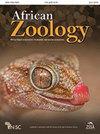Diversity of Benthic Macroinvertebrates in Anthropogenically Disturbed Aturukuku River, Eastern Uganda
IF 0.5
4区 生物学
Q4 ZOOLOGY
引用次数: 3
Abstract
Biodiversity conservation has focused on large vertebrates and plants with pronounced economic value, compared with smaller organisms such as benthic macroinvertebrates that play a particular role in freshwater ecosystems. The increasing loss and degradation of freshwater habitats, coupled with low taxonomic and ecological knowledge and limited conservation efforts in the tropical regions, threaten macroinvertebrate biodiversity. This study investigated spatial and seasonal variability in benthic macroinvertebrate diversity and the underlying environmental variables within the Aturukuku River in Tororo, Uganda. Benthic macroinvertebrates were evaluated by comparing their composition at a reference site in the upstream rural area with two urban midstream sites and one rural downstream site during dry and wet seasons in 2018. Benthic macroinvertebrate diversity in the Aturukuku River was lower than that reported from least disturbed small rivers within the same region; with moderate to high pollution tolerant taxa, dominating. Chironomidae, Oligochaeta and Simulium sp. predominated at the urban sites receiving sewage and abattoir effluent. The Shannon–Wiener diversity index, species richness and species evenness in the river were generally low. Prosobranch (Thiaridae) snails and bivalves (Sphaeridae) were among the taxa with low tolerance to changes in the river. Canonical Correspondence Analysis revealed that total nitrogen, dissolved oxygen, temperature and streambed substrate were predominant in structuring benthic macroinvertebrate assemblages. There was no potential species-rich area for macroinvertebrate conservation, given the poor environmental conditions and diversity in the entire river. However, specific mitigation measures against the declining quality of the river are recommended, to boost conservation of macroinvertebrates and the entire riverine ecosystem.乌干达东部受人为干扰的阿图鲁库库河底栖大型无脊椎动物的多样性
与在淡水生态系统中发挥特殊作用的底栖大型无脊椎动物等较小的生物相比,生物多样性保护的重点是具有显著经济价值的大型脊椎动物和植物。淡水生境的日益丧失和退化,加上热带地区分类和生态知识匮乏以及保护工作有限,威胁着大型无脊椎动物的生物多样性。本研究调查了乌干达托罗罗阿图鲁库库河底栖大型无脊椎动物多样性的空间和季节变化以及潜在的环境变量。通过比较2018年干湿季节在上游农村地区的一个参考点与两个城市中游地点和一个农村下游地点的底栖大型无脊椎动物的组成,对其进行了评估。阿图鲁库库河底栖大型无脊椎动物多样性低于同一区域内受干扰最小的小河;具中至高耐污染分类群,占主导地位。在接收污水和屠宰场污水的城市场地,Chironomidae、Oligochaeta和simum p.占优势。河流的Shannon-Wiener多样性指数、物种丰富度和物种均匀度普遍较低。对河流环境变化的适应能力较差的分类群为拟螺科螺类和双壳类。典型对应分析表明,总氮、溶解氧、温度和河床底物是影响底栖大型无脊椎动物群落结构的主要因素。考虑到整个河流的环境条件和多样性,没有潜在的大型无脊椎动物保护物种丰富区。然而,建议采取具体的缓解措施来应对河流质量下降,以促进大型无脊椎动物和整个河流生态系统的保护。
本文章由计算机程序翻译,如有差异,请以英文原文为准。
求助全文
约1分钟内获得全文
求助全文
来源期刊

African Zoology
生物-动物学
CiteScore
2.60
自引率
9.10%
发文量
18
审稿时长
>12 weeks
期刊介绍:
African Zoology , a peer-reviewed research journal, publishes original scientific contributions and critical reviews that focus principally on African fauna in terrestrial, freshwater, and marine ecosystems. Research from other regions that advances practical and theoretical aspects of zoology will be considered. Rigorous question-driven research in all aspects of zoology will take precedence over descriptive research. The Journal publishes full-length papers, critical reviews, short communications, letters to the editors as well as book reviews. Contributions based on purely observational, descriptive or anecdotal data will not be considered.
The Journal is produced by NISC in association with the Zoological Society of South Africa (ZSSA). Acceptance of papers is the responsibility of the Editors-in-Chief in consultation with the Editors and members of the Editorial Advisory Board. All views expressed are those of the author and not necessarily those of the Editors or the Department.
 求助内容:
求助内容: 应助结果提醒方式:
应助结果提醒方式:


